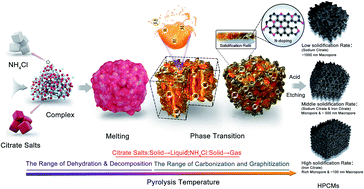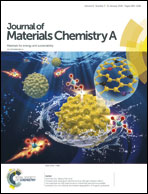A phase-transition-assisted method for the rational synthesis of nitrogen-doped hierarchically porous carbon materials for the oxygen reduction reaction†
Abstract
Herein, we report a phase-transition-assisted strategy that uses gas–liquid separation coupled with a gas–liquid interfacial reaction during the phase transition of precursors for constructing hierarchically porous carbon materials (HPCMs) with tunable interconnected macropore channels, and simultaneously conducting the formation of active sites along these channel walls for the oxygen reduction reaction (ORR). A HPCM with an ultrahigh specific surface area of 1141.41 m2 g−1 and a highly interconnected macroporous network was produced, in which the active sites are exactly located on the mass-transport channels. By adjusting the precursor's solidification rates, the porosity of HPCMs can be exactly tuned from the micrometer to the nanometer level. Such an excellent structure, by benefiting the fast mass transport and maximizing the utilization of active sites, leads to an excellent ORR performance with a half-wave potential of 0.901 V which exceeds that of the state-of-the-art Pt/C catalyst by 40 mV.



 Please wait while we load your content...
Please wait while we load your content...